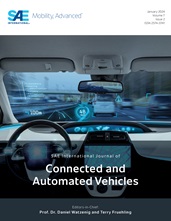The mobility industry is rapidly advancing towards more autonomous modes of
transportation with the adoption of sophisticated self-driving technologies.
However, a critical challenge, being the lack of standardized norms for
defining, measuring, and ensuring vehicle visibility across various dynamic
traffic environments, remains. This lack of awareness of visibility is hindering
the development of new regulations for vehicle visibility and the controlled
transition to a fully-integrated autonomous future.
While current efforts focus on improving sensing technologies like computer
vision, LiDAR systems, and sensor fusion development, two key issues remain
unresolved:
-
1
The absence of a representative and realistic three-dimensional color
visibility model for measuring and comparing the visibility of
complex shapes with large but varying color coated three-dimensional
surface areas.
-
2
The need for enhanced visibility solutions that improve visibility
and vehicle detectability for all traffic participants while
maintaining color styling freedom.
This article presents a new visibility assessment model that measures the
three-dimensional Point-of-View (PoV) Visibility of mobility coatings using a
5-parameter Visibility Label. It evaluates how visible a mobility coating color
is on a complex three-dimensional vehicle shape from a separate observer’s
perspective or an observing device.
Key components of this three-dimensional Point-of-View Color Visibility Model
include:
-
Moving beyond flat panel color design and measurements to a
comprehensive 3D Visibility Model
-
Considering visibility for human vision, computer vision and LiDAR
visibility modalities
-
Establishing automotive glossy solid white as reference color
The Visibility Label helps users understand how visible complex shapes with
different colored coatings are. It quantifies visibility in real-world
scenarios, enabling easy comparison between designs and finishes. This
simplifies decisions on which coatings enhance visibility most.
The article shows that similar colors can have a significant different 3D PoV
Color Visibility. It explores ways to enhance this visibility with new color
coating technologies, particularly through Crystal Glass Pigment (CGP)
formulations that significantly improve 3D color visibility.
The example in Appendix B demonstrates an increase in 3D Color Visibility of 200%
for Human Visibility and 600% for Full Object Visibility for the addition of 5
weight-percent CGP, and 183% increase for LiDAR Visibility for the addition of
17 weight-percent CGP to an existing silvery metallic automotive refinish
color.
By emphasizing the importance of 3D PoV Color Visibility in traffic environments
where human-controlled, semi- and fully autonomous vehicles coexist, and
highlighting the influence of color and shape on vehicle visibility, this
comprehensive approach aims to significantly impact road safety today while
facilitating a controlled transition to an autonomous future.
